The 2018 Apple iPad Pro (11-Inch) Review: Doubling Down On Performance
by Brett Howse & Andrei Frumusanu on December 4, 2018 10:00 AM ESTThe Liquid Retina Display
Apple offers some of the best displays on the market, and the iPad Pro is arguably their best display available. What Apple calls a Liquid Retina display is a 264 pixel-per-inch masterpiece. The 11-inch model we are reviewing holds a 2388x1668 7:5 aspect ratio panel, while the larger 12.9-inch model uses a 4:3 2732x2048 panel.
There’s a lot that sets Apple apart from other manufacturers on the market. The company has taken display accuracy seriously longer than anyone outside of the professional field. The display in the iPad Pro is also a P3 D65 gamut display, but thanks to the color management system that Apple moved over from the Mac, it simultaneous offers near-perfect sRGB reproduction as well as near-perfect P3 reproduction whenever an app or image specifically says it's P3. There’s no compromise on offering the P3, and no need to change the gamut on the display to match different color spaces. It’s a P3 display where sRGB is properly mapped.
In addition, Apple’s iPad Pro offers their ProMotion technology, which means it is a 120 Hz display, but one that supports variable refresh rates in order to lower the display's refresh rate for power management purposes. The iPad Pro will go as low as 24 Hz, presumably chosen to match the framerate of most movies. Apple also carries over its True Tone functionality, where ambient light sensors change the white point of the display to make it more suited to the environment it is in. It’s one of those features you never really knew you needed until you see it in action.
The fully laminated display also offers Apple’s industry leading antireflective coating, which Apple rates at 1.8% reflectivity, improving the results outdoors dramatically over most devices, and of course there is a fingerprint-resistant oleophobic coating as well.
Apple rates the latest iPads at up to 600 nits of brightness too, so pretty much no matter where you are, the combination of the high brightness and the antireflective coating should make for a great viewing experience.
To test the display characteristics, we turn to SpectraCal’s CalMAN software suite, along with an X-Rite i1Display Pro colorimeter for brightness and contrast readings, and the X-Rite i1Pro 2 spectrophotometer for color accuracy readings.
Brightness and Contrast
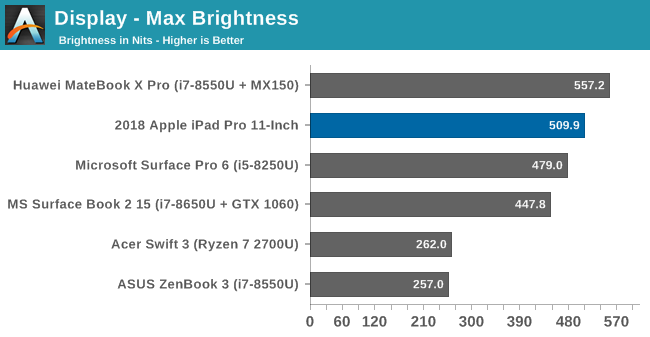
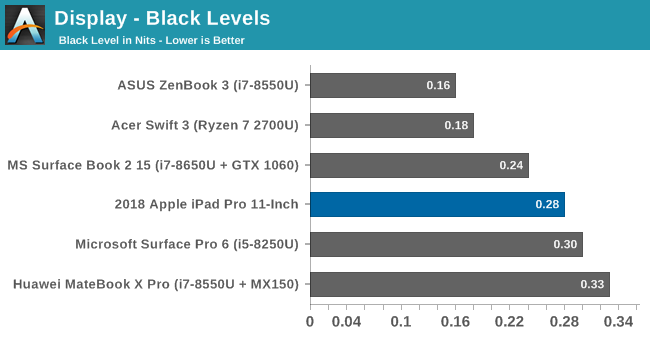
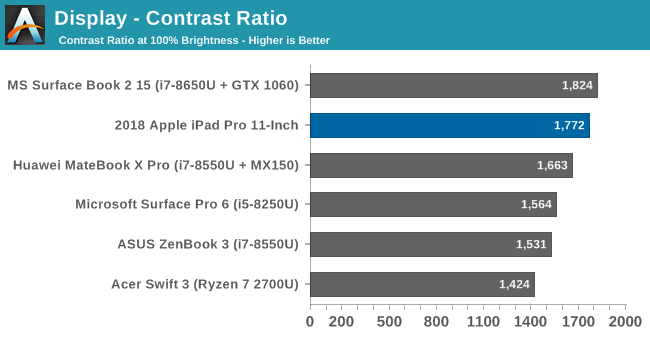
Under our test conditions the iPad Pro could not quite hit the 600 nits that Apple advertises, but at 500 nits it is still plenty bright. Couple that with the excellent contrast ratio of almost 1800:1, and things are off to a good start.
Grayscale
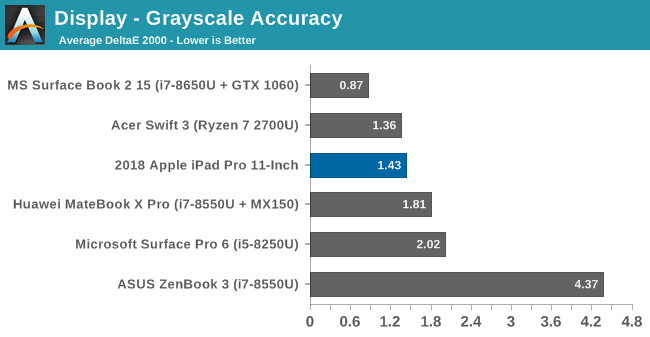
The average dE2000 of 1.43 is a fantastic result, but the gamma isn’t quite perfect, dropping off near 100% because the display was slightly too bright. Unfortunately, the red results were quite low throughout the entire range leading to a slightly cooler display white point, but this is all quite minor.
Gamut
First let’s take a look at sRGB:

As you can see, the sRGB values are almost perfectly mapped into the P3 D65 gamut, and the average error level of just over 1.09 is simply fantastic. All of the primary and secondary values are close to perfect, except red which was a bit low at 100% red, as we saw in the grayscale results.
Next up, P3 D65:
As with the sRGB results, the P3 D65 gamut is also almost perfect. The beauty of color management means that there’s no work for the user to get the benefit of both P3 and sRGB.
Saturation

The saturation sweep was run in sRGB, and as you can see from the graphs, all along all of the primary and secondary colors the error level is basically imperceptible to the human eye.
Gretag Macbeth
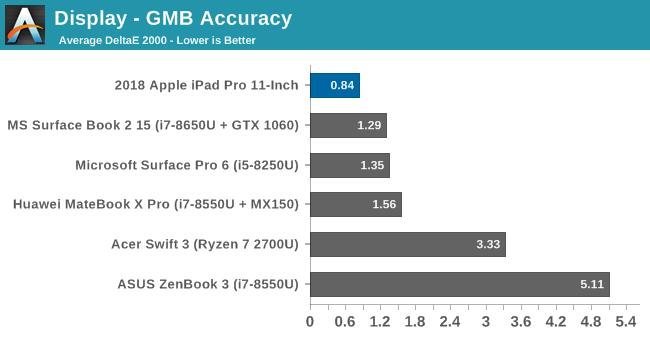
Finally, the Gretag Macbeth test is a more comprehensive test, hitting colors outside of the primary and secondary colors, including the important skin tones. The error level is practically perfect, with no single color even hitting an error level of 2.0.
Display Conclusion
The iPad Pro simply offers one of the best displays on any electronic device. Color accuracy is superb, in both the P3 and sRGB gamuts, and thanks to iOS supporting full color management, customers don’t have to worry about if they are working on a P3 or sRGB image. The addition of True Tone makes for an incredibly pleasing white point in pretty much any situation, and the 120 Hz display refresh rate makes for smooth scrolling, while stepping down to lower refresh rates to conserve power when the display is static.


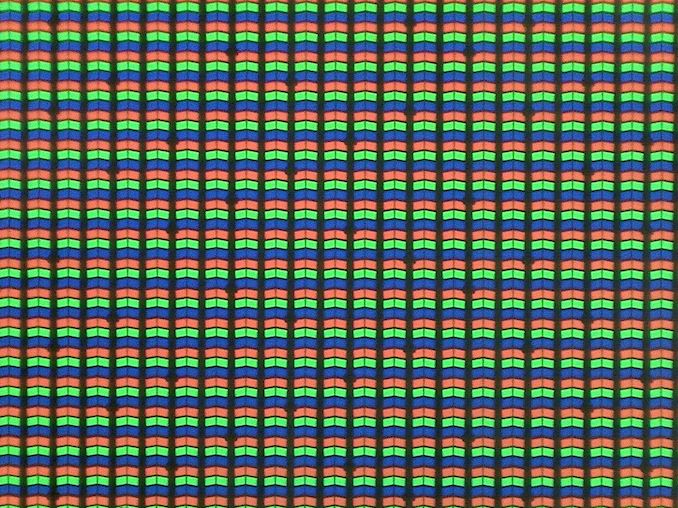


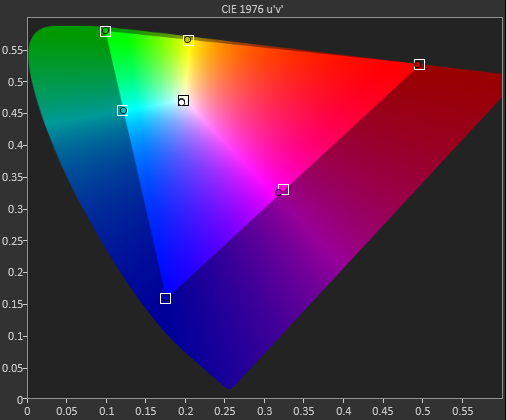










145 Comments
View All Comments
tipoo - Tuesday, December 4, 2018 - link
You can snap a lot of tablets in half with your bare hands, the longer a device is the easier it is to get that leverage.Solution: Probably don't snap your tablet in half with your bare hands
darkich - Wednesday, December 5, 2018 - link
..even if you put it in a bag it is likely to bend over time.Getting it now?
blackcrayon - Wednesday, December 5, 2018 - link
If you put it in a bag and stand or stomp on the bag, yes...melgross - Tuesday, December 4, 2018 - link
Oh, sheesh, just go away!blackcrayon - Wednesday, December 5, 2018 - link
Ha, and just think there are $3000 laptops where you can snap the screen hinge just by strongly bending it back or twisting it. Better dodge that falling sky!WasHopingForAnHonestReview - Wednesday, December 5, 2018 - link
Please end it.SSTANIC - Tuesday, December 4, 2018 - link
How are SPEC results same if A12X has 4 big cores instead of 2 in A12, I don't geddit.. Is it a single core benchmark?thunng8 - Tuesday, December 4, 2018 - link
Yes, single core only. There is a spec_rate benchmarks, but that wasn't testedGC2:CS - Tuesday, December 4, 2018 - link
I saw the teardown of this thing. Actually I saw this detail on the Apple promo video itself...Doesn’t the RAM package look sort of like HBM sitting on an interposer to you ?
The RAM chips are siting right next to the A12X heatspreader, nothing like that in previous iPads and if anything they at least saved some space this way.
Needs some chip analysis ASAP.
tipoo - Tuesday, December 4, 2018 - link
It's a DRAM chip, but it certainly looks like it could be getting ready for a future like Intels EMIB where they have HBM2 or something else on-package.